What if you could have a portable power station to keep electronics running during a power outage or while camping? Better yet, what if you could charge it not just from a household outlet or your car, but in the sun via collapsible solar panels?
Portable solar power stations are designed to do just that.
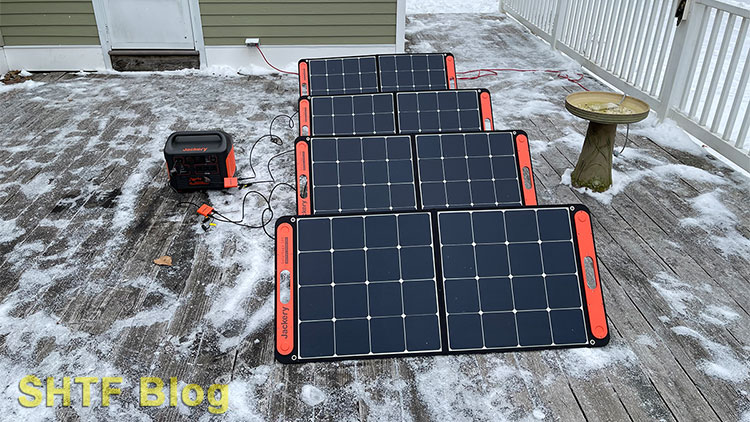
The technology on these solar charging power banks has come a long way. What was once something used largely on small boats has advanced to the point at which homeowners can use them to get through short-term natural disasters. Off-grid campers can power everything from coffee makers to radios.
This is a review of my Jackery Explorer 1500 Solar Generator with 4 100W solar panels.
Why Get a Solar Power Station?
A solar power station is not going to give you anywhere near the power that a conventional, fuel-based generator will provide. I can fire up my Briggs and Stratton generator during a power outage and run my entire house off it with ease. I store multiple jerry cans full of no-ethanol gas mixed with fuel stabilizer for this very reason. I could power the house for days with what I have on hand.
This begs the question: Why own a solar power bank at all?
There are plenty of reasons why you might choose a solar power station over a gas-run generator. There are plenty of reasons why you might want both.
Fuel Source
The most obvious advantage to a solar power bank is its fuel source – the sun. Sunlight is 100% free. You don’t have to store it. You don’t have to worry about buying more. If you have sunlight – you have power.
Emissions
Generators poison thousands of people every year. Anytime we have a serious winter storm roll in that knocks power out for a few days, it’s inevitable that I’ll see at least one report of someone dying from the carbon monoxide emitted from their portable generator.
Those poisonings and deaths can be prevented with education and proper ventilation, but that doesn’t change the fact you have to contend with emissions.
A solar power station doesn’t have this problem. Because it’s a charged battery versus an engine, there are no emissions to contend with. You can use your portable power bank inside the home with no worries. You can use it in a tent, in your van, wherever.
Noise
In my neighborhood, if the lights going out don’t tell you there’s a power outage, the engines of neighbors’ generators will. My Briggs and Stratton generator is loud. Yes, you can buy large, quiet generators (Honda makes them), but you will pay a big premium for one.
A small power station on the other hand is quiet. Short of the soft hum of the cooling fan that kicks on once in a while, it’s entirely silent.
This makes it ideal for camping, indoor use, or anywhere that people are just hoping to hear one another talk without yelling.
In dangerous situations, where noise brings risk, its low decibel rating could also be a safety feature.
Tailgating
If you enjoy tailgate camping, parking lot partying, or anything of that nature, solar power stations are a great choice. One charge will easily power what you need for a day of tailgating. The silent noise will allow you to enjoy the experience with your friends, and you won’t be annoying others with the sound of an engine.
Portability
My Briggs and Stratton generator is portable in that it has two wheels on one end and a folding handle on the other. I can heft it up by the handle and push or pull it into place. Getting that into the back of my truck to take it somewhere would be a Herculian effort, however. Taking it somewhere by vehicle requires ramps and plenty of muscle or a few very large guys. Ideally both!
Weighing only 35 pounds, my Explorer 1500 power bank can easily carry it from one place to the next.
Size is another factor. While my gas generator might power the entire house, it’s way too much generator for most smaller jobs. Getting it into the bed of a truck is a big enough hurdle. Getting into the back seat of a car would be impossible. It’s just. Too. Big.
Jackery 1500 Specifications
The 1500 package that I have is pictured below. Four large panels sit against the wall, there’s the power bank, and the case for the power cords.
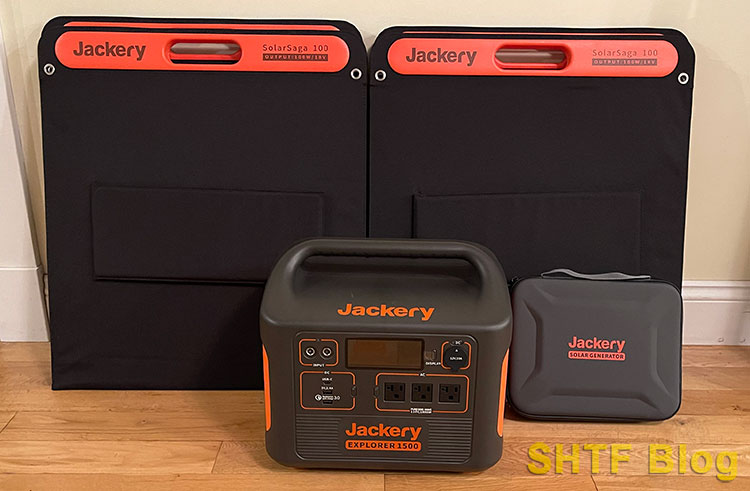
The power station’s specifications are as follows.
| Battery Capacity | 1534.68Wh (60.9Ah/25.2V) |
| Weight | 16kg (35.27lbs) |
| Dimensions | 35.6×26.4×32.3cm (14×10.4×12.7in) |
| DC Input | 2x24V=10.5A (Dual-input supports 500W max at 12-30V) |
| AC Input | 3x110V-60Hz, 16.4A 1800W max continuous 3600W surge peak |
| Car Port | 12v=10A |
| USB Output | USB-A Output: 5V=2.4A USB-C PD Output: 5V=3A, 9V=3A 12V=3A, 15V=3A, 20V=3A Qualcom Quick Charge 3.0 Output: 5-6V=3A, 6.5-9V=2A; 9-12V=1.5A |
Price
You can buy just the portable power station itself (no solar panels) for around $1600 (at time of this writing). Jackery does offer periodic sales and discounts, so watch for those if you’re in the market but not in a hurry.
This could be the perfect ticket for the person looking solely for a massive battery bank that they can charge just in their car or at home. Perfect for day trips to the beach, tailgating, or short-term power outages. Jackery does offer other sizes to fit different needs and budgets.
Solar panels can be purchase separately at some future date or all together as a package for a discount.
Operation
Operating this system is about as easy as it can get. It’s all plug and play, which starts with…
Charging
Any Jackery power station should be fully charged to start. This is how you want to store it as well – fully charged. You never know when you might need it for an unexpected emergency or you just want to take it on a boat for the day. Whatever the need, it’s always ready if you keep it charged.
The one thing you want to avoid is using the power station while simultaneously charging it. It can be done in a critical situation, but too much of it will reduce the life of the battery.
Most people will just plug it into a household outlet, leave it for a few hours, and bam – it’s charged. Then set a reminder for every 3 months to top off the charge.
When not in use, store your solar power station like you store your food, in a cool dry place.
Function
Simple function is where a portable power station like this really shines. There is no oil to check, no choke to work, no engine to turn over, no spark plugs, nothing. You just plug in whatever you want to run, tap the small power button next to the outlet or port, and that’s it!
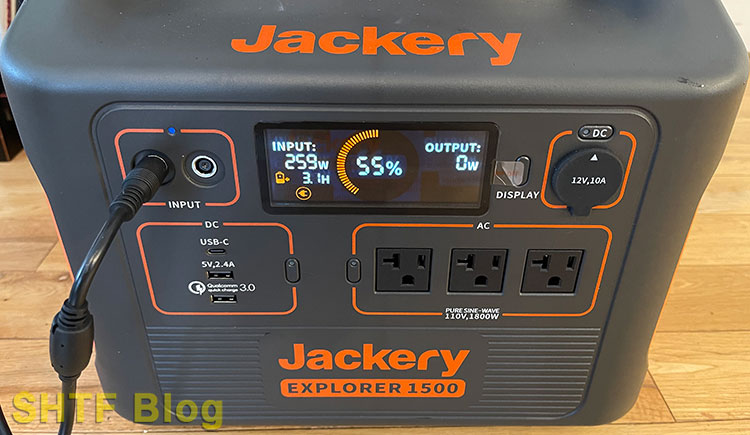
SolarSaga Folding Solar Panels
The 4 Solar Saga solar panels included in my package are rated to generate 100 watts each. They are well-built, fold in half, and have a carry handle incorporated. When in the folded position, they stay closed by built-in magnetic ends.
The are good sized, even when folded. Stored somewhere for an emergency, that’s not a problem. However, it’s something to be mindful of if you are tight for space (e.g., van life).
| Peak Power | 100 W |
| Cell Efficiency | 23% |
| Power Voltage | 18V |
| Power Current | 5.55A |
| Open Circuit Voltage | 21.6V |
| Short Circuit Current | 6.1A |
| USB-A Output | 5V = 2.4A |
| USB-C Output | 5V = 3A |
| Dimensions (unfolded) | 1220x535x5mm |
| Dimensions (folded) | 610x535x35m |
The panels can be used by connecting the DC interface with the adapter (included) and plugging that into the DC input of the Explorer 1500. Two can also be connected together into one charging line. In this way you can connect up to 4 panels into the 2 charging inputs.

Four is the maximum number of panels that can be used to charge the power bank at one time. You can always use fewer. It will just take longer to reach a full charge.
Setting the panels upright to face the sun is easy because each panel has two built in collapsing legs to prop them up.
Testing and Performance
Viewing the power station as a possible battery bank for at-home use during a crisis, I tested the Explorer 1500 on a cold winter day. Not the best conditions!
Charge Time
Jackery lists the recharge times below.
| Solar Charger: 400W Max | Wall Charger: 500W Max | Car Charger: 100W Max |
|---|---|---|
| Around 4 hours | Around 3 hours | Around 15.5 hours |
In my earlier photo you saw that my wall outlet was running 259 watts, the battery was at 55% capacity, and there were 3.1 hours left. This seems generally consistent with Jackery’s claim of a 500 watt wall outlet charging from 0 at around 3 hours.
I’m not a fan of outrageous claims by manufacturers, so I was pleased to see my experience was consistent with their claim.
To test the solar panels’ charging capacity, I picked about the worst day you could find. There was no sun at all, only a gray, overcast sky. I set everything out on my back deck and plugged it all in.

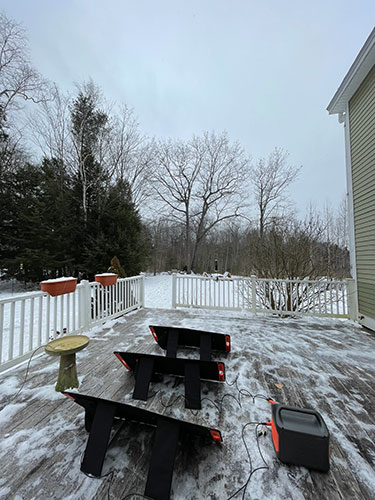
Despite having virtually no sun, the portable power station still charged, just very, very slowly. See below that the 4 panels were pushing in 28 watts and it had an estimated 39 hours to become fully charged from 55%.

I will be interested to try this unit on a warm summer day.
Run Time
The following chart comes from the 1500 user manual. Jackery notes that the results come from the laboratory with an ideal temperature. “Real world” results will be determined by various factors, but Jackery’s lab results should serve as a rough guide.
| Device | Coffee Maker (1120W) | Air Fryer (1700W) | Toaster (650W) | Car Fridge (60W) | Drone (90W max) | Motion Camera (5W Max) |
| Run Time | About 70 minutes | About 0.6-1 hours | About 1.8-3.6 hours | About 90 hours | About 30 recharges | About 250 recharges |
In my house, if the power goes out in the winter, the first thing that comes to mind is running the fan on the fireplace insert. If you’re unfamiliar with these, they’re essentially a wood stove inserted into a fireplace.
They will throw heat on their own, but because so much of the stove actually sits inside the fireplace, it’s nothing like a wood stove sitting in the room. Unless I’m running the fan, that is.
There’s a fan that sucks air underneath the stove box and pushes it up around the back of the stove and back out the top. This cools the stove, but more importantly, it blasts hot air into the room. Very warm!
If the power goes out, I need to keep that fan running if I’m to keep the first floor heated.
With this in mind, I plugged the fan into the power station and let it run for the day. At the eight hour mark kids were complaining that the house was too hot so I turned it off. The unit still had a 55% charge left on it. Impressive!
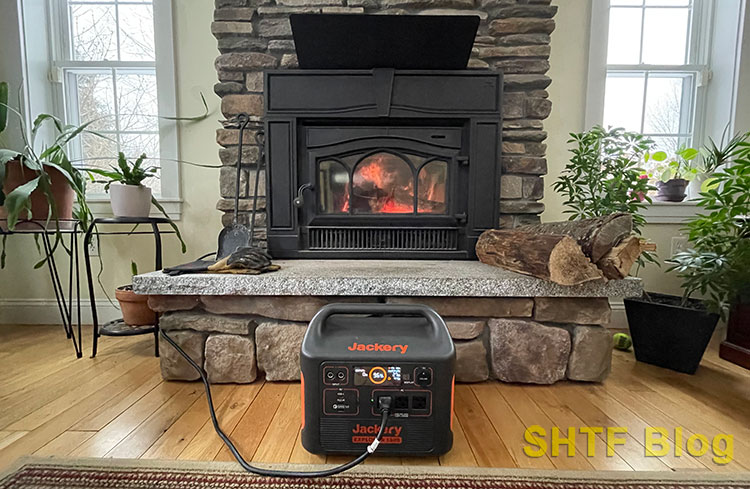
FAQs
Are Jackery solar generators any good?
The Jackery Explorer 1500 is an impressive piece of equipment. If you appreciate quality, you will be pleased with their products. The system is rugged and well-crafted. They cut no corners that I can find.
Are there higher-end solar generators? Most likely. But you have to balance price with quality. The quality-to-price ratio decreases the higher you go. A low-end solar generator is likely to be junk and not worth spending the lower amount. A higher-end unit is the inverse, a lot of money for a small improvement in performance.
Jackery units offer a healthy balance of cost to quality.
What can a 1500 watt generator run?
Think of a 1500 watt generator as an “on the go” generator and you’ll probably grasp what it can run. For example, you’re not going to run your electric clothes dryer on a 1500 watt generator (you need more than 5000). You’re not going to run a sump pump either (starting watts are too high).
What can you run? A coffee maker, toaster, radio, television, game console, fan, lights, etc.
Of course, the more products you plug in, the harder time a 1500 watt generator will have keeping up.
How many watts do I need to power my house?
Generally, you will need anywhere from 5000 to 10000 watts to power a house. This depends on how big your house and how much power you want (or need) to draw. A smaller home just trying to keep essentials running during a blackout can likely get by with 3500 watts, but for extra assurance draw the bottom line at 5000.
Final Notes
Jackery products come with a solid 24-month warranty. This long warranty speaks to their confidence in their product and should add some credibility and assurance to prospective buyers.
Remember, this is a piece of electrical equipment. If you’re in the market for one as a means to help protect your home from an EMP, you’ll want to protect your power station from an EMP as well. Store it in a large Faraday cage or buy a Faraday bag that it will fit in.

